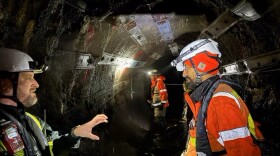The state’s Orca Recovery Task Force will deliver its final recommendations to Gov. Jay Inslee on Friday. Among the controversial items on the list is a last-minute proposal for a temporary ban on whale watching tours near the endangered Southern Resident orcas.
The state Department of Fish and Wildlife suggested it as an alternative to a no-go zone west of San Juan Island. It’s proposed to last three to five years.
But some whale-watch companies are concerned it would create false impressions about their industry.
Shane Aggergaard, a past president of the Pacific Whale Watch Association who runs his own company, says tours right now rarely see the endangered orcas. But many other species of whales are thriving and the whale watching is better than he has seen in 25 years.
“We have a huge population of humpbacks, which has been an incredible boom," Aggergaard said. "Transient killer whales, which are absolutely thriving, we have a population of Minke whales, which is very consistent, our grey whales in the spring. But we see very few Southern Residents.”
He says recent encounters with the endangered orcas make up about 15 percent of their business, so the temporary ban would not have a huge impact on the industry. But he thinks commercial whale-watch boats play an important educational role and also help scientists track the whales.
The Whale Watch Association says other regulations, such as the proposal for a “go-slow bubble” within a half mile of Southern Residents, would be more effective. This is a voluntary practice they have already introduced to reduce impacts from noise.
“We just want to make sure we do what’s best to help recover Southern Resident killer whales,” Aggergaard said.
Chinook Recovery Key
Others say implementing the proposed temporary ban would be a showy distraction from items on the task force list that might be harder to implement, but should be higher priority.
Robb Krehbiel, with the nonprofit Defenders of Wildlife, served on the task force's Prey Availability Working Group. He says that while limiting disturbances around the orcas is essential, the biggest issue facing them is a lack of fish for them to eat.
“We can reduce noise as much as we want," Krehbiel said, "but without more salmon in the water, then all those measures that we put into place aren’t going to do anything.”
He says finding ways to restore Chinook salmon runs is key. The top of Krehbiel's list includes increasing the spill rates over the Columbia River dams — so that juveniles can make it all the way out to the ocean — and increasing habitat protection, especially through restoration of estuaries.
Another important goal is removing the four dams on the Lower Snake River. Krehbiel wants legislators to get to work right away on a transition plan, “for how we will continue to meet the needs of folks that currently depend on these dams, after the dams are removed.”
These include farmers and cities in Southwest Washington, an area that relies on the dams for energy production, irrigation and barging.
And he says there are other, smaller dams at several locations in Washington that should be considered for removal as well.
For all 35 recommendations, Krehbiel says he's heard cost estimates ranging from $60 million to more than a billion dollars.
Starting Friday, it will be up to the governor — followed by the Legislature — to prioritize and find funding sources. The Orca Recovery Task force will reconvene for its second year of work next May.







